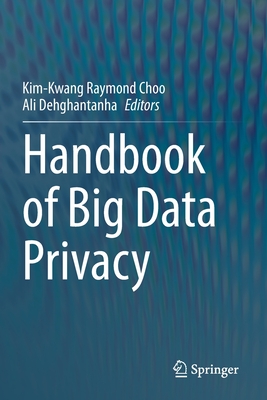Handbook of Big Data Analytics and Forensics
暫譯: 大數據分析與取證手冊
Choo, Kim-Kwang Raymond, Dehghantanha, Ali
- 出版商: Springer
- 出版日期: 2022-12-04
- 售價: $7,940
- 貴賓價: 9.5 折 $7,543
- 語言: 英文
- 頁數: 287
- 裝訂: Quality Paper - also called trade paper
- ISBN: 3030747557
- ISBN-13: 9783030747558
-
相關分類:
大數據 Big-data、Data Science
海外代購書籍(需單獨結帳)
相關主題
商品描述
This handbook discusses challenges and limitations in existing solutions, and presents state-of-the-art advances from both academia and industry, in big data analytics and digital forensics. The second chapter comprehensively reviews IoT security, privacy, and forensics literature, focusing on IoT and unmanned aerial vehicles (UAVs). The authors propose a deep learning-based approach to process cloud's log data and mitigate enumeration attacks in the third chapter. The fourth chapter proposes a robust fuzzy learning model to protect IT-based infrastructure against advanced persistent threat (APT) campaigns. Advanced and fair clustering approach for industrial data, which is capable of training with huge volume of data in a close to linear time is introduced in the fifth chapter, as well as offering an adaptive deep learning model to detect cyberattacks targeting cyber physical systems (CPS) covered in the sixth chapter.
The authors evaluate the performance of unsupervised machine learning for detecting cyberattacks against industrial control systems (ICS) in chapter 7, and the next chapter presents a robust fuzzy Bayesian approach for ICS's cyber threat hunting. This handbook also evaluates the performance of supervised machine learning methods in identifying cyberattacks against CPS. The performance of a scalable clustering algorithm for CPS's cyber threat hunting and the usefulness of machine learning algorithms for MacOS malware detection are respectively evaluated.
This handbook continues with evaluating the performance of various machine learning techniques to detect the Internet of Things malware. The authors demonstrate how MacOSX cyberattacks can be detected using state-of-the-art machine learning models. In order to identify credit card frauds, the fifteenth chapter introduces a hybrid model. In the sixteenth chapter, the editors propose a model that leverages natural language processing techniques for generating a mapping between APT-related reports and cyber kill chain. A deep learning-based approach to detect ransomware is introduced, as well as a proposed clustering approach to detect IoT malware in the last two chapters.
This handbook primarily targets professionals and scientists working in Big Data, Digital Forensics, Machine Learning, Cyber Security Cyber Threat Analytics and Cyber Threat Hunting as a reference book. Advanced level-students and researchers studying and working in Computer systems, Computer networks and Artificial intelligence will also find this reference useful.
商品描述(中文翻譯)
本手冊討論了現有解決方案中的挑戰和限制,並介紹了來自學術界和產業界在大數據分析和數位取證方面的最新進展。第二章全面回顧了物聯網(IoT)安全性、隱私和取證文獻,重點關注物聯網和無人機(UAV)。作者在第三章中提出了一種基於深度學習的方法來處理雲端的日誌數據,並減輕枚舉攻擊。第四章提出了一種穩健的模糊學習模型,以保護基於IT的基礎設施免受持續性威脅(APT)攻擊。第五章介紹了一種先進且公平的工業數據聚類方法,能夠以接近線性的時間訓練大量數據,並在第六章中提供了一種自適應深度學習模型,以檢測針對網絡物理系統(CPS)的網絡攻擊。
作者在第七章評估了無監督機器學習在檢測工業控制系統(ICS)網絡攻擊中的性能,下一章則介紹了一種穩健的模糊貝葉斯方法,用於ICS的網絡威脅獵捕。本手冊還評估了監督式機器學習方法在識別針對CPS的網絡攻擊中的性能。對於CPS的網絡威脅獵捕的可擴展聚類算法的性能以及機器學習算法在MacOS惡意軟體檢測中的有效性也分別進行了評估。
本手冊繼續評估各種機器學習技術在檢測物聯網惡意軟體中的性能。作者展示了如何使用最先進的機器學習模型來檢測MacOSX網絡攻擊。為了識別信用卡詐騙,第十五章介紹了一種混合模型。在第十六章中,編輯們提出了一種利用自然語言處理技術生成APT相關報告與網絡殺傷鏈之間映射的模型。最後兩章介紹了一種基於深度學習的方法來檢測勒索軟體,以及一種檢測物聯網惡意軟體的聚類方法。
本手冊主要針對在大數據、數位取證、機器學習、網絡安全、網絡威脅分析和網絡威脅獵捕領域工作的專業人士和科學家作為參考書籍。高級學生和研究人員在計算機系統、計算機網絡和人工智慧領域的學習和工作中也會發現這本參考書有用。
作者簡介
Kim-Kwang Raymond Choo received the Ph.D. in Information Security in 2006 from Queensland University of Technology, Australia. He currently holds the Cloud Technology Endowed Professorship at The University of Texas at San Antonio (UTSA). He is an IEEE Computer Society Distinguished Visitor (2021 - 2023), and a Web of Science's Highly Cited Researcher in the field of Cross-Field - 2020. In 2015, he and his team won the Digital Forensics Research Challenge organized by Germany's University of Erlangen-Nuremberg. He is the recipient of the 2019 IEEE Technical Committee on Scalable Computing (TCSC) Award for Excellence in Scalable Computing (Middle Career Researcher), the 2018 UTSA College of Business Col. Jean Piccione and Lt. Col. Philip Piccione Endowed Research Award for Tenured Faculty, the British Computer Society's 2019 Wilkes Award Runner-up, the 2014 Highly Commended Award by the Australia New Zealand Policing Advisory Agency, the Fulbright Scholarship in 2009, the 2008 Australia Day Achievement Medallion, and the British Computer Society's Wilkes Award in 2008. He has also received best paper awards from the IEEE Consumer Electronics Magazine for 2020, EURASIP Journal on Wireless Communications and Networking (JWCN) in 2019, IEEE TrustCom 2018, and ESORICS 2015; the Korea Information Processing Society's Journal of Information Processing Systems (JIPS) Survey Paper Award (Gold) 2019; the IEEE Blockchain 2019 Outstanding Paper Award; and Best Student Paper Awards from Inscrypt 2019 and ACISP 2005.
Since receiving his PhD in 2011, Dr. Dehghantanha has made significant contributions to the fast-moving fields of cybersecurity and cyber threat intelligence. He is a Canada Research Chair in Cybersecurity and Threat Intelligence, and an EU Marie-Curie Fellow Alumni in digital forensics. Dr. Dehghantanha has pioneered the use of ML-based systems for threat hunting in IoT/ICS devices using physical characteristics (e.g. power consumption) as opposed to application-level characteristics (e.g. IP addresses). His works have resulted in an Intrusion Detection System (IDS) for IoT networks; and deep learning models for threat hunting in the edge layer of ICS networks. In 2019, with support from the Department of National Defense Canada, he has developed the first multi-view fuzzy machine learning system for cyber threat attribution. He is among few academics contributing to fundamental research in cyber threat intelligence, with most research taking place in industry settings. His work helps define this new discipline while informing practical strategies. He has built a Cyber Kill Chain-based threat intelligence framework for analyzing banking Trojan campaigns which is widely used to model different attack campaigns, including APT groups activities, analyzing crypto-ransomware campaigns, and analyzing Advanced Persistent Threat (APT) groups targeting critical national infrastructure. He is currently the director of Cyber Science Lab at the University of Guelph, Ontario, Canada.
作者簡介(中文翻譯)
金光瑞蒙·秋於2006年在澳洲昆士蘭科技大學獲得資訊安全博士學位。他目前擔任德克薩斯州聖安東尼奧大學(UTSA)的雲技術講座教授。他是IEEE計算機學會的傑出訪客(2021 - 2023),並於2020年被Web of Science評選為跨領域的高被引研究者。2015年,他和他的團隊贏得了德國埃爾朗根-紐倫堡大學主辦的數位取證研究挑戰賽。他獲得了2019年IEEE可擴展計算技術委員會(TCSC)可擴展計算卓越獎(中期研究者)、2018年UTSA商學院Col. Jean Piccione和Lt. Col. Philip Piccione終身教授研究獎、英國計算機學會2019年Wilkes獎的亞軍、2014年澳洲和紐西蘭警務諮詢機構的高度表彰獎、2009年富布萊特獎學金、2008年澳洲日成就獎勳章,以及2008年英國計算機學會的Wilkes獎。他還獲得了IEEE消費電子雜誌2020年的最佳論文獎、EURASIP無線通信與網絡期刊(JWCN)2019年的最佳論文獎、IEEE TrustCom 2018的最佳論文獎,以及ESORICS 2015的最佳論文獎;2019年韓國資訊處理學會的資訊處理系統期刊(JIPS)調查論文獎(金獎);IEEE區塊鏈2019的傑出論文獎;以及Inscrypt 2019和ACISP 2005的最佳學生論文獎。
自2011年獲得博士學位以來,德赫甘坦哈博士在快速發展的網絡安全和網絡威脅情報領域做出了重要貢獻。他是加拿大網絡安全和威脅情報的研究主席,以及歐盟瑪麗·居里獎學金的數位取證校友。德赫甘坦哈博士開創了基於機器學習(ML)系統在物聯網/工業控制系統(ICS)設備中使用物理特徵(例如:功耗)進行威脅獵捕的研究,而非應用層特徵(例如:IP地址)。他的研究成果包括針對物聯網網絡的入侵檢測系統(IDS)以及針對ICS網絡邊緣層的威脅獵捕深度學習模型。2019年,在加拿大國防部的支持下,他開發了首個多視角模糊機器學習系統,用於網絡威脅歸因。他是為數不多的在網絡威脅情報基礎研究方面做出貢獻的學者,大多數研究發生在產業環境中。他的工作有助於定義這一新學科,同時提供實用策略。他建立了一個基於網絡殺傷鏈的威脅情報框架,用於分析銀行木馬攻擊活動,該框架廣泛用於建模不同的攻擊活動,包括APT組織的活動、分析加密勒索病毒攻擊活動,以及分析針對關鍵國家基礎設施的高級持續威脅(APT)組織。他目前是加拿大安大略省圭爾夫大學網絡科學實驗室的主任。














